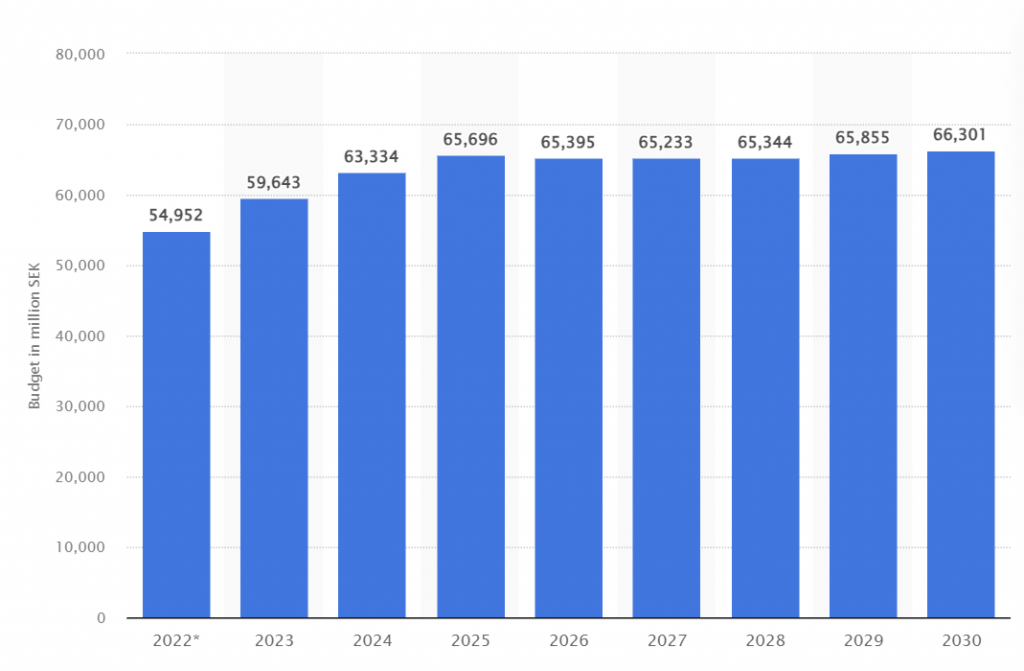By Jonathan Michael Feldman, March 13, 2023
The Good News: Fewer Dirty Flights
A recent news story in Dagens Nyheter (DN) (February 5th) reported that “emissions from Swedes’ air travel were almost as significant as the emissions from all passenger car traffic in the country before the pandemic.” From 1990 to 2017, “the climate impact from aviation increased by 47 percent.” In addition, “emissions from aviation are nearly 1 ton per person per year, the same level that each Swede should have as the total emission level for all consumption over an entire year by 2050 at the latest – if the Paris Agreement is to be achieved.” Swedes “fly more than five times as much as the global average.” Scholars argue that despite the promise of alternative, greener technologies “Swedish aviation must decrease significantly and very rapidly if the goals of the Paris Agreement are to be within reach.” In addition, last year “there were 31 percent fewer landings at Swedish airports than in 2017.” When “measured by the number of passengers at Swedish airports,” there were “23.5 percent fewer passengers in 2023 compared to 2017.” Underlying this story is a happy national narrative about how Swedes are making good choices because they realize that if they fly more, people won’t make needed changes in this and other areas.
The Bad News: Eroded Substitution Effects and Countervailing Problems
There is a very large potential problem with this analysis and these arguments. They can be explained logically: A causes B, where A is less desirable behavior based on a given need C. Here A is flight travel using traditional fuels and methods of propulsion, B are emissions and C is flight travel. What the DN article does not address in any detail are the substitutes for A, although we learn that they are not sufficient for meeting climate goals at present. Yet, if D is the clean substitute that might affect B. We always have the choice between A and D, with D reducing B. So even if people flying less is desirable, we still need to account for how for how to get more D.
There is a kind of discursive moment in which academic research faces certain boundaries of scope in questions asked and these boundaries often fit into journalistic routines. In the case in question, we get research about how and why people fly less with the answers fitting into a news story. These routines beg the question, however, about how and why emissions can be reduced as a whole, not just in this sector.
There is a strong case to be made about sectoral focus, picking targets in given industries and changing them. Then, we can focus on networks and exchanges among specific suppliers, consumers, regulations, and the like and make very specific recommendations and interventions that meet the parameters of the target. The problem or limit, however, is when lessons from one sector do not spill over into other sectors because of some larger totality.
The larger totality can be expressed as follows: E causes massive emissions. When A is being reduced, E increases and E also reduces the possibility of substitutes D at least in potential funding to accelerate, improve and expand D. And what is E? E is Sweden’s entry into NATO. NATO is a major polluter, membership demands more military spending and more military spending means fewer resources that could be invested into electric planes as well as something else, which I call F. What is F? F represents the study circles, museums, public radio and television broadcasts, peace movement activities and other cultural and democracy-enhancing activities which could enhance the activities of social movements seeking broad ecological changes. Swedish politicians have moved to reduce F because of the Swedish Democrats, Sweden’s far-right party that is increasingly normalized. E is enhanced and F reduced by Swedish militarism which the happy national narrative is consistent with because of the mystical belief that Russia would attack Sweden or some other country in the European Union.
NATO versus the Happy National Narrative
We owe Dr. Ho-Chih Lin, Nick Buxton, Mark Akkerman, Deborah Burton, and Wendela de Vries a great deal for helping us to gain data about the costs NATO represents to our ecosystem. Their recent article in Relief Web, “Climate crossfire: How NATO’s 2% military spending targets contribute to climate breakdown,” explains: “NATO’s goal of 2% spending of GDP on the military will accelerate climate breakdown by diverting billions of dollars from climate finance and increasing greenhouse gas emissions. This year alone, NATO members spent $1.26 trillion on their militaries. This report shows that this could have paid for 12 years of promised – and still not delivered – climate finance to impoverished countries to help them deal with the climate crisis.”
The authors explain that while “climate mitigation and adaptation efforts are chronically underfunded by billions of dollars” which deepens the climate crisis, “the richest and most carbon-polluting nations are also increasing military expenditure.” In fact, “climate finance one of the most contentious issues at annual United Nations climate summits” where “as “the richest countries that bear the most responsibility for climate breakdown have failed to keep even their limited promises of finance for those facing its harshest consequences.” The trend in E, NATO resource costs, is going to increase: “Global military spending has reached a record high of $2.24 trillion, more than half of this spent by NATO’s 31 member states, and budgets are projected to increase massively in the next few years.” Finally, “the total military carbon footprint of NATO rose from 196 million metric tonnes of CO2 equivalent (tCO2e) in 2021 to 226 million tCO2e in 2023 – 30 million tonnes more in two years, equivalent to putting more than 8 million extra cars on the road.”
Another study by Ugur Korkut Pata and colleagues, published in the Journal of Cleaner Production in July 2023, analyzed the effects of NATO military expenditures (MEX) “income, energy consumption, financial development, and technical progress on carbon emissions spanning the period from 1991 to 2018.” They found that “income, energy consumption, and MEX all contribute to a rise in emissions.” They also found that “high MEX are closely related to various environmental and sociocultural problems such as air pollution, access to electricity and drinking water, infant mortality, and low life expectancy,” citing the research of Ceyhun Elgin and colleagues published in 2022. In addition, “NATO has high MEX and military equipment, weapons, and
construction increase demand for fossil fuels. Even without war, military transportation activities lead to an expansion of CO2 emissions from fossil fuel use.” Discussions of NATO’s “greening,” are a vast distraction from the opportunity costs of the enterprise, particularly how its expansion fuels conflicts and thus emissions.
In short, while A (Swedish flights) are reducing and thus reducing C (emissions), E is increasing and thus increasing C. Furthermore, as noted above, increases in E represent an economic and democracy opportunity cost to F, associated with fewer resources for clean aviation technology and the cultural/democratic institutions whose development is needed to fight various forms of emissions.
Swedish Militarism: Expanding the Frontier of Opportunity Costs
John Hill at Airforce Technology (April 3, 2023) explained that last year, Sweden’s defense budget reached $8.7 billion, which equated “to a yearly increase of 17.3%.” In addition, “GlobalData expects Sweden will meet NATO’s 2.0% target figure by 2028,” representing a $13.4 billion military budget. In total, there would be “a positive compound annual growth rate (CAGR) of 6.2% from 2024 to 2028.” In sum, “Sweden currently spends 1.4% of its GDP on defence, up from 1.2% in 2022.” In September 11, 2023, Reuters reported that “boosted its planned defence budget for 2024, taking the total planned increase for the year to 27 billion crowns ($2.44 billion) and exceeding the NATO threshold of 2% of GDP.” The planned increase in Swedish military expenditures can be seen in Figure 1. I have already outlined in detail repeatedly the totally irrational character of Swedish militarism in various essays, most recently in an essay published on March 7th.
Figure 1: Expected defense budget for Sweden from 2022 to 2030 (in million SEK)

Source: “Expected defense budget for Sweden from 2022 to 2030(in million SEK),” Statista, 2024, accessible at: https://www.statista.com/statistics/1231756/expected-defense-budget-for-sweden/.
Conclusions
The happy national narrative is what we can expect as Sweden does better than other nations while simultaneously trying to resemble other nations in NATO expansion, militarism, and accelerating the ecological opportunity costs of NATO. The problem we face is a moving target. If Sweden does better while the climate problem becomes bigger and faster, being better than others is but a Pyrrhic victory. I believe the happy national narrative distracts from the bigger targets and problems, i.e. the trillions of dollars spent on militarism that are urgently needed to address economic inequality, climate threats, and the joint venture of militarists and the far-right to retard democracy and traditional cultural intermediaries. We can learn from the reduced flights one happy lesson, but there is a looming unhappy lesson that has not be learned. What is that?
The unhappy lesson is the bulldozing of democracy by militarists who are part of a global ecocide movement where Sweden is a contributing player. The alternatives to this unhappy national un-narrative are rather clear. They are found in addressing the ecological power gap in Sweden, which was the subject of another essay published in Global Teach-In. We must also reverse cultural lags and other elements of political consciousness which fail to address problems.
